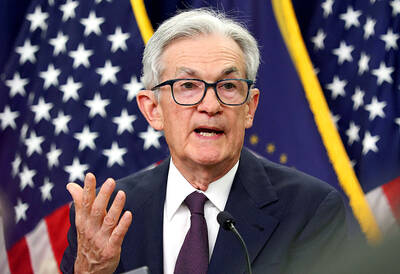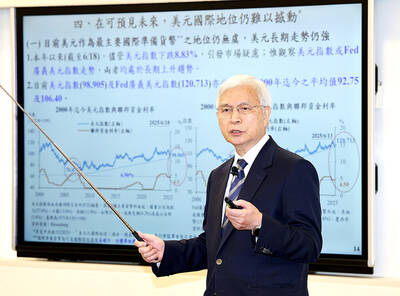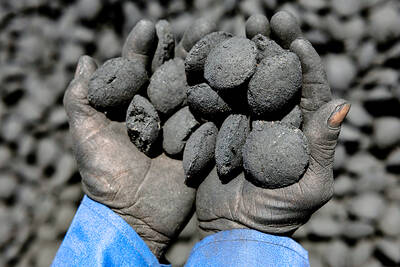The World Bank yesterday raised its forecast for China’s economic growth this year and next, but warned that subdued household and business confidence, along with headwinds in the property sector, would keep weighing it down next year.
The world’s second-biggest economy has struggled this year, mainly due to a property crisis and tepid domestic demand.
An expected hike in US tariffs on its goods when US president-elect Donald Trump takes office next month might also hit growth.

Photo: Reuters
“Addressing challenges in the property sector, strengthening social safety nets, and improving local government finances will be essential to unlocking a sustained recovery,” World Bank country director for China Mara Warwick said in a statement. “It is important to balance short-term support to growth with long-term structural reforms.”
Thanks to the effect of policy easing and near-term export strength, the World Bank sees China’s GDP growth at 4.9 percent this year, up from its June forecast of 4.8 percent.
Beijing set a growth target of about 5 percent this year, a goal that it says it is confident of achieving.
Although growth for next year is also expected to fall to 4.5 percent, that is still higher than the World Bank’s earlier forecast of 4.1 percent.
Slower household income growth and the negative wealth effect from lower house prices are expected to weigh on consumption into next year, the World Bank said, adding that a turnaround in the property sector is not anticipated until late next year.
To revive growth, Chinese authorities have agreed to issue a record 3 trillion yuan (US$411 billion) in special treasury bonds next year, Reuters reported this week.
The figures are not being officially unveiled until the annual meeting of China’s parliament, the National People’s Congress, in March, and could still change before then.
China’s middle class has expanded significantly since the 2010s, encompassing 32 percent of the population in 2021, but World Bank estimates suggest that about 55 percent remain “economically insecure,” underscoring the need to generate opportunities.

DIVIDED VIEWS: Although the Fed agreed on holding rates steady, some officials see no rate cuts for this year, while 10 policymakers foresee two or more cuts There are a lot of unknowns about the outlook for the economy and interest rates, but US Federal Reserve Chair Jerome Powell signaled at least one thing seems certain: Higher prices are coming. Fed policymakers voted unanimously to hold interest rates steady at a range of 4.25 percent to 4.50 percent for a fourth straight meeting on Wednesday, as they await clarity on whether tariffs would leave a one-time or more lasting mark on inflation. Powell said it is still unclear how much of the bill would fall on the shoulders of consumers, but he expects to learn more about tariffs

NOT JUSTIFIED: The bank’s governor said there would only be a rate cut if inflation falls below 1.5% and economic conditions deteriorate, which have not been detected The central bank yesterday kept its key interest rates unchanged for a fifth consecutive quarter, aligning with market expectations, while slightly lowering its inflation outlook amid signs of cooling price pressures. The move came after the US Federal Reserve held rates steady overnight, despite pressure from US President Donald Trump to cut borrowing costs. Central bank board members unanimously voted to maintain the discount rate at 2 percent, the secured loan rate at 2.375 percent and the overnight lending rate at 4.25 percent. “We consider the policy decision appropriate, although it suggests tightening leaning after factoring in slackening inflation and stable GDP growth,”

Meta Platforms Inc offered US$100 million bonuses to OpenAI employees in an unsuccessful bid to poach the ChatGPT maker’s talent and strengthen its own generative artificial intelligence (AI) teams, OpenAI CEO Sam Altman has said. Facebook’s parent company — a competitor of OpenAI — also offered “giant” annual salaries exceeding US$100 million to OpenAI staffers, Altman said in an interview on the Uncapped with Jack Altman podcast released on Tuesday. “It is crazy,” Sam Altman told his brother Jack in the interview. “I’m really happy that at least so far none of our best people have decided to take them

As they zigzagged from one machine to another in the searing African sun, the workers were covered in black soot. However, the charcoal they were making is known as “green,” and backers hope it can save impoverished Chad from rampant deforestation. Chad, a vast, landlocked country of 19 million people perched at the crossroads of north and central Africa, is steadily turning to desert. It has lost more than 90 percent of its forest cover since the 1970s, hit by climate change and overexploitation of trees for household uses such as cooking, officials say. “Green charcoal” aims to protect what